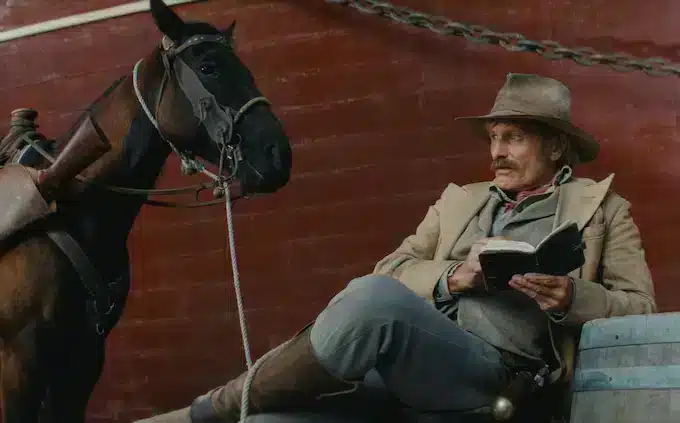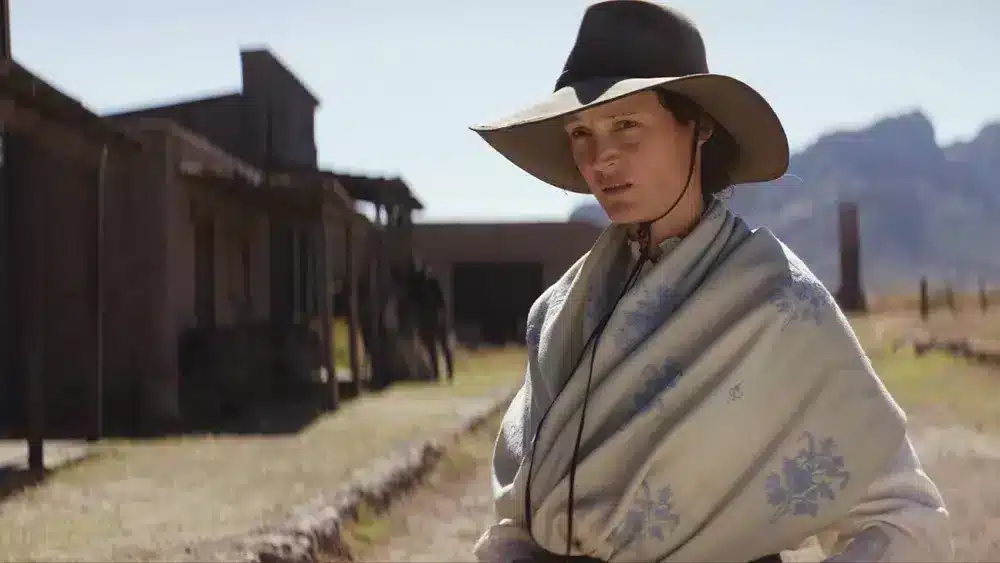
The Dead Don’t Hurt plays with the concepts of gender in the Western. It takes place in the 1860s, and the central character is a woman. I tried to make a classic style Western in many ways, but what hopefully makes it unique and somewhat subversive is that there’s a point at which the male figure goes away to war, for a much longer time than the audience expects, and instead of going with him, which is what we typically see in movies, we remain with her. The story clearly becomes about her experience: that of a quietly stubborn, independent person. That’s what interested me.
I don’t approach making movies or stories in a conceptual way, it’s more instinctive. The Dead Don’t Hurt (2024) is the second movie I’ve directed. The first was Falling, which was released during the Covid-19 Pandemic in 2020. I was reading a variety of books and watching a lot of older movies, including Westerns, as many did during the pandemic lockdown in 2020, and doing a fair amount of writing. An image of a girl with a rich imagination, running around in a forest, came to me. I was thinking about my mother and things I knew about her childhood, the landscape she lived in as a girl. But that was only a starting point; I wanted to understand this character I was writing about, so I began the screenplay at a moment that was important and final, the last moments of the character’s life as an adult, and then deconstructed, returning to her childhood. When something significant or difficult happens to us, we’re inclined to think about how and why we arrived at that point. We’re not always in the present, we think back a lot. You can see a face or hear a sound or recall a scent and suddenly you’re 12 years-old or 20 again. I know it’s more common for novels to jump back and forth in time, but movies and TV stories are now doing that a lot too. It’s an approach I like personally. Falling had a similar non-linear approach. The next story I’ll try to tell may unfold in linear fashion, however.
Good writing allows space for the reader to construct the story for themselves. Well before starting to participate in movie-storytelling, when I was writing poetry and short stories, I tended to focus on taking away non-essential material from the finished pieces. How much can you take from a poem and still understand it? How much can you take out of a movie story? You do this as you’re writing, then as you’re shooting and finally editing the material you have. It often depends on how proficient the performers are, how much they are able to transmit without words. Certainly when you’re editing a movie, you have to be cold about the process—especially if you wrote it. There will be entire scenes or moments that are beautiful but if the rhythm is wrong, they must go. You have to remove these parts unemotionally. I don’t have a problem with that. Maybe because I’ve been editing books for a long time. In the end, it has to work. Nobody’s going to care that you have this profound scene in the middle if you’re bored by the time you get to it. When you’ve finished the movie and present it to the public, it becomes their movie. If they are engaged, they will follow the story and add their own views on what happens in it, filling in details in their own way, according to their personal experiences and tastes.
I learned a lot from Lisandro Alonso [the director of Jauja and Eureka]. What I like about him as a filmmaker, and why I’ve returned to work with him, is that when he tells a story, it is as though he is telling it to himself. He’s making it for an audience of one. That’s not selfish or reckless, that’s being an artist. And that’s what I admire about him.

Both of my collaborations with Alonso were written by Fabián Casas, a great Argentine poet. What Lisandro appreciated in him I also value: his unique voice as a writer, but also his particular, dry sense of humour. You can certainly see and hear this in Jauja. Lisandro and I connected with what Fabián was trying to say. The awkwardness of the character I played, especially in his relationship with his daughter… it’s very much in the Casas spirit. I am drawn to the way Lisandro Alonso collaborates. He has unpretentiously and easily made a family with the people he has told stories with over the past twenty years, and Fabián and I quickly became additions to that family. When you work with directors, you always hope you will understand each other in a profound as well as practical way, but it doesn’t always happen. With Lisandro it certainly did.
I’ve played characters who are racist and violent. I don’t believe in imposing my personal values on any role I play. If I accept a role, I commit to being fully inside it, without judgement. If I am playing a character who is violent, or full of misogyny, I’m doing it for a reason—because it is essential to the story. Some actors will play a villain and hope the audience likes their character regardless of what is done and said. I’m not a fan of playing to or for the audience. I’d prefer they see my characters for who they really are, inasmuch as the director and I can get that across.
My approach in filmmaking or acting resembles what I do as a book publisher. At Perceval Press, the small independent publishing house we founded in 2002, we look for stories that are interesting to us, artists and work that I have learned something from and want to share with others, stories that might otherwise not be published. It’s not necessarily the most commercially-effective way to do things, but I believe we end up producing books in a way that makes the process and end result equally enriching. We take a similar approach to selecting the movie stories that Perceval Pictures has a hand in producing.
Filmmaking is a collective enterprise. That’s what I like about movies. It’s a complete universe in terms of art, design, visuals, music, acting and movement—there are so many elements that go into it.
Making movies is about solving new obstacles every day. From writing, to shooting and then editing, I seem to always be asking myself, ‘how do I solve this problem?’ Sometimes I think it’s going to be a simple day, and then something doesn’t align. But the process is about overcoming these situations against a running clock, and the best way is to pull together as a group. Filmmaking is a collective enterprise. That’s what I like about movies. It’s a complete universe in terms of art, design, visuals, music, acting and movement—there are so many elements that go into it. But a movie is also only as good as the compromises made by the individuals who create it together. It’s not about one person. When I direct, I want as much participation as possible.
The Lord of the Rings, on a practical level, was a long, rich film education. Like any collaborative experience, you get out of it what you put in. To be on that long, long shoot with a local crew that, for the most part, had little experience up to that point but who more than made up for that with tremendous enthusiasm, provided a beautiful learning experience for all of us. By the end, everyone was in sync and very proficient, inspired by a director who was exploring new ways of telling a big movie story. It was fascinating to watch all of the departments work. We were all free to observe people building sets, making costumes and props, devising all manner of approaches to daily film- making obstacles. There was constant access to the ongoing creative process. I learned a great deal on that shoot. It was obvious that Peter Jackson and his team were creating something special, and it won’t ever happen quite that way again, because of how technology in cinema has evolved. The practical challenges met to build that epic movie story, and the grass-roots approach to shooting for so many months—years, in the end—is now much less common. In terms of acting in that story, it’s akin to being in a play that goes on for an extended period, where you continue working on that one character and their interrelationships month after month. ‘Aragorn’ became second-nature to me. That’s a great experience to have had. While some may find it boring to work on a character for so long, I cherished the experience and felt I’d been given the time to truly inhabit the role and contribute as much as possible to what Peter Jackson was trying to accomplish.





